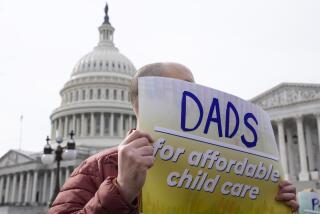Science / Medicine : DAY CARE : Millions of children each day go off to day care while their mothers go off to work. Troubling new research shows that the quality of that care may be a real cause of concern.
Child care has become nearly as essential to American families as the automobile and the refrigerator. Yet most families find it far easier to purchase high-quality appliances at reasonable prices than to find even minimally adequate child care.
What impact is this having on America’s youth? Should mothers feel guilty that they are not staying home with their young ones?
In comparing child care to the most basic household appliances, Sandra Scarr, chairman of the Psychology Department at the University of Virginia and author of the book “Mother Care--Other Care,” underscored the dilemma modern women now face: They are afraid to ask questions about the impact of their jobs on their families because no matter what the answer, they will most likely continue to work outside the home anyway, either because they want to or they have to.
By the U.S. Department of Labor’s reckoning, more than 50% of American mothers of infants and preschoolers are now in the labor force. By 1995, the Department of Labor anticipates, about two-thirds of all new workers will be women, and 80% of those will have children during their years at work.
Yet day care--whether it comes in the form of a preschool, a day-care center, a live-in nanny or an untrained baby sitter or housekeeper--has come to be in critically short supply in the United States, according to the experts.
A report by the Foundation for Child Development, released last week by the U.S. Conference of Mayors, said an estimated 45% of the need for licensed child care in the United States goes unmet.
Even more troubling, the latest research is now leading to the conclusion that the quality of day care in America is highly suspect.
“The problem isn’t with day care, the problem is with day care as we know it and have it in this country today,” said Jay Belsky, another of the country’s leading experts on day care and a professor of human development at Pennsylvania State University.
In the first wave of studies of day care in the 1970s, the news was all good, Belsky said. Not only did the children in day care do well but there was some indication that they did better, in such areas as IQ tests, than did their counterparts at home with their mothers. The early studies, however, focused almost exclusively on highly successful, university-based centers.
“Today,” he said, “we’re looking at a much wider variety of situations . . . and, not surprisingly, we’re finding a much broader array of results.”
But the results are confusing, said Lewis P. Lipsitt, professor of psychology and medical science at Brown University and director of Brown’s Child Study Center.
There is no consumer guide to child care in America and if there were, it is unclear how reliable its ratings would be since experts themselves are widely divided on the subject of which kind of care is best for whom and under what conditions.
Where there is research, it is often contradictory and sometimes of extremely poor quality, perhaps reflecting America’s indifference to the question of day care in general.
Nonetheless, the experts say, some patterns are emerging. Some of them are reassuring. Others are quite alarming.
For example, a well-regarded study to be published next year by researchers in Dallas followed retrospectively the lives of hundreds of third graders in six elementary schools, some of whom had been solely in their mothers’ care, others of whom had been placed in day care during the early months or weeks of their lives. The researchers concluded that those youngsters who had been in day care were more uncooperative socially and less successful academically than their peers who stayed at home with their mothers. The results are not a reflection of economic or social differences, which were controlled in the study, according to several experts who have seen preliminary results of the study.
In contrast, there have been at least 30 studies of children in surrogate care showing that there is no detrimental effect on a child’s intellectual development and that there are many benefits, said child-care expert Allison Clarke-Stewart in her book “Daycare.” By and large, day-care youngsters tend to be more verbal, have more complex speech patterns and better memories than do any other group of children, she said.
That is especially true, many experts agree, for poor and disadvantaged children whose home environments are rarely as enriching as even a moderately good day-care center. But, some experts believe, there is also persuasive evidence that middle-class children may benefit from the stimulation of day care, as well. One of the reasons may be, Scarr said, that mothers at home are often busy with other things and spend far less time with their children than our “fantasies” about motherhood might lead us to believe.
Such a view is expected to be firmly supported by another much-awaited study, just completed in Sweden and also scheduled for publication next year. Reaching precisely the opposite conclusions of the Dallas researchers, the Swedish experts found that in the eight years they followed groups of children, the children who were in day care suffered no adverse consequences from non-maternal influences and benefitted from their surrogate caretakers in a variety of ways.
Other European countries, as well as Canada, also have advanced child-care programs and policies, due largely, according to historians, to post-World-War-II efforts to establish child-care centers that would allow women to remain in the work force to help rebuild their countries’ war-devastated economies. During the same period, many American women returned to the home front, making way for their husbands to resume the roles of breadwinners after the war.
Bruno Bettelheim, one of this country’s foremost experts on child development, argues that the 1950s in America were an aberration in American history and that far too much has been made of the notion that women stayed home with their children. In fact, Bettelheim said, women in the ‘50s were off playing bridge and doing volunteer work. The erratic nature of their comings and goings and their willingness to leave their children voluntarily for periods of time may have been harder for the children to understand than it is for them to grow up knowing that their mothers are breadwinners within the family, he said.
Bettelheim is one of many renowned experts in the United States who have weighed in on the subject of day care versus maternal care. Another is Dr. T. Berry Brazelton, a Harvard psychiatrist, who is author of numerous popular child-care books.
Brazelton has long emphasized what he calls “the important period of intense communication” between mother and child during the months after birth and he insists that this period is a crucial time when trust and emotional bonds are established within the child.
Does that mean that a mother should not return to work during her child’s first year of life for fear of risking her child’s emotional stability later on?
It is on this point that researchers in the field seem most divided.
At a recent meeting of the American Academy of Pediatrics, Scarr of Virginia and Belsky of Penn State argued openly over what the research on the subject has shown so far.
Belsky pointed to a number of studies showing that children whose mothers left during their first year of life have had emotional problems later on, particularly in making what are thought to be critical attachments to their own mothers.
But Scarr argued that there is little evidence to support Belsky’s view, at least in situations where the surrogate care is warm, supportive and consistent. And even when children do develop emotional problems, she insisted, the research has consistently shown that the problems are minor and are very transitory in nature.
Even Scarr acknowledged, however, that the timing of the mother’s departure can be a crucial factor in the future success of a child’s development. Ideally, she said, the child should be left before the age of 6 or 7 months or after 18 months--but not in between.
Jerome Kagan, a child psychologist and long-recognized expert in child development, has explained why. Between the ages of 6 or 7 months and 18 months, babies develop what is known as separation anxiety. They are old enough for the first time to recognize people. But they are too young to comprehend that if someone they know and love goes away, that person will most likely return again--and probably very soon.
Researchers conclude that if there is to be surrogate care it should be stable care. There should be as little turnover as possible.
Child-care training, as opposed to experience, probably makes more difference than most families would like to believe, particularly families in New York and Los Angeles, who in large numbers rely on immigrant women to care for their children, Scarr said. Whether these immigrant helpers have characteristics that compensate for their lack of education or whether they could be more effective with even brief exposures to workshops on child development theories, no one knows because so far there have been no comprehensive studies done on the subject, she said.
There are other studies that point up intriguing side benefits that may go along with child care.
For example, while it is surely true that a mother who works even part time spends less time with her children, husbands of working women fairly universally seem to spend more time with their children than do husbands whose wives do not work at all. The reason, some experts theorize, may have to do with a need of working mothers to share responsibilities at home and a tendency of full-time mothers to be more possessive of their children even when they are dealing with their own husbands.
Similarly, said Marilyn J. Essex, a psychologist at the University of Wisconsin, men whose wives work at least part time report less depression and stress than those whose wives do not work.
“Look at some of the factors involved. . . . The mother may be happy about going to work and relaxed about giving over her baby in the morning, or she may be distressed. . . . At home in the evening, the mother may not have time to play with the baby because she is swamped with housework, or the baby sitter or her husband may do the housework, leaving her evenings free. Her husband may be unhappy about her returning to work, so their evenings with the child become tense, or her husband may support her. And, of course, babies differ in temperament from one to another, so they react differently to all these factors. Clearly, no one study can take all of this into account.”
COMPARATIVE WEEKLY COSTS FOR CHILD CARE
According to the U.S. Bureau of Labor Statistics, 56% of women with children under the age of 6, or about 9 million women, work outside the home. About 23% of children six and under are cared for in organized day-care centers.
Family Day Care Day-Care Center School Care-giver Age Comes to Age Cost Age Cost Program Child’s Home Boston 0-2 $45-160 0-2 $90-150 $30-40 $260-340 2-5 $40-160 2-5 $75-110 New York 0-2 $35-140 0-2 $60-150 $20-60 $165-300 2-5 $40-160 2-5 $75-110 Atlanta 0-2 $30-60 0-2 $35-70 $20-35 $165-230 2-5 $30-55 2-5 $50-70 St. Louis 0-2 $45-50 0-2 $65-80 $10-32 $165 and up 2-5 $40-160 2-5 $75-110 Dallas 0-2 $50-70 0-2 $60-90 $25-35 $165-200 2-5 $50-70 2-5 $50-70 Denver 0-2 $65-105 0-2 $65-105 $30 $165-200 2-5 $55-105 2-5 $55-105 San 0-2 $55-90 0-2 $90-120 $1/hour $165-200 Francisco 2-5 $55-85 2-5 $65-90
*Los Angeles was not included in this study.
Source: Dana Friedman, Conference Board, 1985






